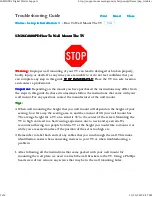
PRODUCT MANUAL FOR WALL MOUNT SERIES ASSEMBLIES
Page 9 of 15
info@practicalqualitysystems.com
WW.PRACTICALQUALITYSYSTEMS.COM (818) 993-1022
Document Number:10010901-UM
8.1 Attaching the mounting plate to a pole
The
P1
or
P3
mounting plate can be attached to any 1 ½” or smaller OD (Outside Diameter) tube with
U bolts for ceiling or pole mounting. Obtain two U bolts that have a ¼” OD diameter shaft, and are 2” wide
center to center. The U bolts must be long enough to go around the pole and through the ends of the
mounting plate.
9.1 Installing and adjusting the Universal Printer Mounting Tray (UPMT)
The width of the
UPMT
will expand to support printers from 5” to 9 ½” wide. To extend or retract the
sides of the
UPMT
, turn one of the small round knobs on either of the sides on the middle of the
UPMT
until the desired width is adjusted.
The
UPMT
will tilt from the level position to 30 degrees forward. To adjust the forward tilt, carefully
loosen the two three-pointed knobs which are on each side of the front of the
UPMT
. Raise or lower the
rear of the tray to the desired tilt angle and tighten the knobs to secure the tilt position. Be advised, some
types of printers will erroneously indicate that they are low on printing paper when they are tilted too far
forward.
9.2 UPMT cabling tips
Route the data and power cables and connect them loosely to the printer. After testing your printer for
correct operation, use small plastic cable ties, or hook and loop ties, to attach the cables to the metal tie
loops at the rear of the
UPMT
, be sure that the cable connectors will not be strained when the printer
repositioned. Then with more ties, form the printer cables into a single bundle to create a cable leash that
extends from a point near the mounting plate location to the rear of the printer tray. Be sure to leave
enough slack cable so that the printer can be moved through its entire range of motion.
9.3 Monitor or touch screen cabling tips
Route the data, power, and other cables and connect them loosely to the screen.
After testing your screen for correct operation, use small plastic cable ties, or hook and loop ties, to attach
the cables to the plastic roller behind the middle of the tilt head, so that the cable connectors will not be
strained when the printer is repositioned. Then with more ties, form the screen cables into a single bundle
to create a cable leash that extends from a point near the mounting plate location to the rear of the tilt
head. Be sure to leave enough slack cable so that the printer can be moved through its entire range of
motion.

































